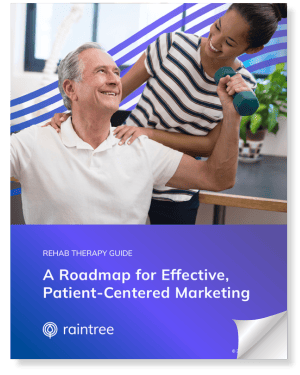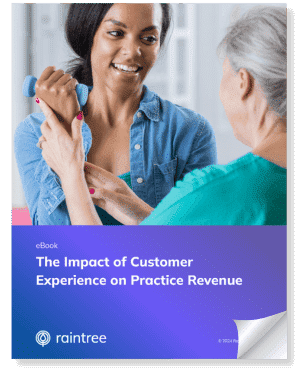
What do rehabilitation therapy and marketing have in common?
In both, long-term success depends on really, truly understanding the struggles, concerns, and aspirations of the people you’re trying to reach—or treat.
When it comes to attracting new patients to your practice, the solution lies in aligning your tactics with the needs and expectations of your target market. In other words, your practice marketing strategy needs to be more than just sell, sell, sell schedule, schedule, schedule. From the start, it’s about empowering your future patients to take the next step for their health, before you’ve even met them.
So, how do you make sure your practice is the preferred choice for those seeking rehabilitation therapy? Let’s build your outpatient therapy practice marketing playbook around your patients’ needs and top decision drivers.
The Key to Attracting New Patients
Understanding your target market goes beyond just knowing what you can provide them, like OT, PT, or SLP services.
Instead, it requires a patient-centered mindset and a good dose of empathy. When you have a firm grasp on your patients’ pain points—literal or metaphorical—it’s easier to show exactly how your practice will take care of them.
To start attracting new patients, you want a clear idea of your unique audience. Some marketers find it useful to create “audience personas,” which embody the needs, lifestyle factors, and interests of those who you’re trying to reach.
Example 1: The Working Professional With Chronic Pain
Consider Sarah, a working professional in her mid-40s who suffers from chronic lower back pain due to years of desk-bound work.
Her needs revolve around swift relief and minimal disruption to her busy schedule. By understanding motivations, you can develop messaging that emphasizes quick and effective pain management solutions. You can make your practice an attractive and convenient choice by offering online scheduling options and telehealth appointments.
Example 2: Parents Seeking Pediatric Speech Therapy
Meet David and Emily, whose daughter was recently diagnosed with autism and has a speech delay.
For parents of children facing communication challenges, decision drivers revolve around trust, empathy, and outcomes. Parents will rely on your professional expertise, clear guidance, and emotional support. In this scenario, your strategy should emphasize a child-friendly environment, experienced therapists, and a track record of positive outcomes. Real-life testimonials from parents who have seen their children flourish under your care can inspire trust and confidence.
Example 3: The Athlete With a Sports Injury
Imagine Liam, a college soccer player who has sustained an injury on the field. He’s super tech-savvy, and uses health apps and wearable devices to monitor his own health goals.
His decision drivers are centered on a swift recovery and returning to peak performance. In this case, focus your strategy on showcasing your expertise in sports rehabilitation, highlighting the success stories of athletes you’ve helped. For patients who are tuned-in to their own health, consider building out your social media platforms and blog articles with actionable, data-driven fitness tips.
In each scenario, your potential patients are actively seeking specialized therapy and rehabilitation to meet their needs. To stand out among the competition and grow your clinic, let’s look at three key decision drivers that can lead patients right to your practice website.
Decision Driver #1: Visibility and Your Online Presence
According to Google, health-related searches make up about 7% of the search engine’s total daily traffic. That’s 70,000 queries each minute. Is your practice at the top of the list when patients are searching for care in your area?
There are many ways to improve your online visibility by optimizing your practice website, provider listings, and social media platforms.
Driving Traffic to Your Website
Think of your website as the digital face of your practice. Content on your site allows you to greet and educate your potential patients before they choose their next PT, OT, SLP, or ABA provider. To create a value-generating site, you’ll need a three-pronged strategy that includes a great user experience, SEO-friendly content, and well-placed advertising.
Build Out Your Practice and Provider Listings
Partnering with provider listings or healthcare marketplaces like ZocDoc can significantly amplify your visibility to help get new patients.
Listings help your patients find you faster, with easily accessible provider listings, comparisons, and contact forms. Plus, having a detailed, up-to-date profile on such platforms can put a friendly face to your name.
Stay Present on Social Media
A scoping review of social media use found that patients often turn to platforms such as Facebook, Twitter, YouTube, and even TikTok for information regarding diseases, medication, and treatment. When your brand becomes a source of helpful and reliable information on their social feeds, patients are more likely to think of you when in need.
“Edutainment,” patient success stories, and behind-the-scenes content on social media can help with attracting new patients and engaging current ones.
Decision Driver #2: Convenience and Accessibility
Convenience is more than a preference—it’s a critical factor in meeting patients’ diverse schedules and accessibility needs. To make sure your clinic is the convenient choice, you can leverage online scheduling, telehealth, and automated communication tools.
Online Appointment Requests
Implementing an efficient online appointment system empowers patients to set up visits at their convenience. User-friendly interfaces and real-time availability updates make it easy for patients to book appointments on their own time rather than waiting for office hours. This saves your staff time, too!
Offer Telehealth Services
Telehealth services provide a lifeline for patients who face mobility challenges, live in underserved rural areas, or have busy schedules. Virtual sessions can make your practice accessible to a broader demographic, ensuring patients receive the care they need despite travel constraints.
Re-engage Existing Patients
The simplest way to fill your schedule could be at your fingertips! We’re talking about patients who have fallen out of care and those who have completed treatment but may require new services. It’s important to continually engage your existing patient base through email and SMS reminders, offering an easy way to get back on track for better health.
Decision Driver #3: Trust and Reputation
Trust is the cornerstone of any successful patient-practitioner relationship. And building trust requires providers and practices to demonstrate transparency, credibility, and a genuine commitment to improving lives. Patients often lend extra weight to the opinions of their trusted primary care physicians and peers. For that reason, your reputation is often built on the way you manage referral relationships, respond to reviews, and address patient barriers to care.
Bringing in Referrals
Professional relationships with referring providers are a testament to your reliability. Collaborating with local healthcare professionals and specialists builds a network that fosters warm hand-offs from general healthcare to your specialty practice. For larger practices, strategic partnerships with hospital systems can enhance credibility and expand your reach.
Encourage Positive Reviews
Positive reviews can speak to your practice’s effectiveness and culture. That’s why savvy marketers actively encourage satisfied patients to share their experiences. Patient engagement tools simplify the process by making it easier for patients to share honest feedback or submit public reviews. Of course, you can’t avoid 100% of complaints. How you respond to those “negative” reviews will define your integrity and compassion.
Address Barriers to Care
In order to get patients in the door, you have to know what’s stopping them from taking that next step.
For some, a lack of trust can come from bad experiences with past providers. Addressing barriers to care might include sharing transparent pricing and payment options, or focusing on inclusive marketing and DEI best practices, or offering telehealth appointments to increase access to care.
Turning New Leads into New Patients
Once the potential patient has done their part—that first contact or referral—the ball is officially in your court.
From there, you’ll need to intake, engage, and retain patients. Solutions like Raintree’s patient engagement suite can help grow your practice by nurturing strong relationships. With Connect, you can efficiently manage inquiries, schedule appointments, and nurture relationships by leveraging scalable automations, specialized templates, and intuitive workflows. We also offer a modern patient portal, digital intake, and cost-efficient patient payment platform.
The right tools will save time, work for your staff (and against burnout!), and create a positive patient experience from the very beginning.
Prepare for Long-Term Practice Growth
Are you ready to grow your practice to the next level?
Raintree Systems designed our comprehensive EHR and practice management solutions to elevate mid-size and enterprise rehabilitation therapy practices. Ready to discuss your long-term growth? Request a demo of our all-in-one platform for rehab and physical therapy.

